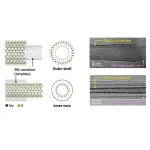AI pain recognition system could help detect patients’ pain before, during and after surgery
2023-10-14
(Press-News.org) SAN FRANCISCO — An automated pain recognition system using artificial intelligence (AI) holds promise as an unbiased method to detect pain in patients before, during and after surgery, according to research presented at the ANESTHESIOLOGY® 2023 annual meeting.
Currently, subjective methods are used to assess pain, including the Visual Analog Scale (VAS) — where patients rate their own pain — and the Critical-Care Pain Observation Tool (CPOT) — where health care professionals rate the patient’s pain based on facial expression, body movement and muscle tension. The automated pain recognition system uses two forms of AI, computer vision (giving the computer “eyes”) and deep learning so it can interpret the visuals to assess patients’ pain.
“Traditional pain assessment tools can be influenced by racial and cultural biases, potentially resulting in poor pain management and worse health outcomes,” said Timothy Heintz, B.S., lead author of the study and a fourth-year medical student at the University of California San Diego. “Further, there is a gap in perioperative care due to the absence of continuous observable methods for pain detection. Our proof-of-concept AI model could help improve patient care through real-time, unbiased pain detection.”
Early recognition and effective treatment of pain have been shown to decrease the length of hospital stays and prevent long-term health conditions such as chronic pain, anxiety and depression.
Researchers provided the AI model 143,293 facial images from 115 pain episodes and 159 non-pain episodes in 69 patients who had a wide range of elective surgical procedures, from knee and hip replacements to complex heart surgeries. The researchers taught the computer by presenting it with each raw facial image and telling it whether or not it represented pain, and it began to identify patterns. Using heat maps, the researchers discerned that the computer focused on facial expressions and facial muscles in certain areas of the face, particularly the eyebrows, lips and nose. Once it was provided enough examples, it used the learned knowledge to make pain predictions. The AI-automated pain recognition system aligned with CPOT results 88% of the time and with VAS 66% of the time.
“The VAS is less accurate compared to CPOT because VAS is a subjective measurement that can be more heavily influenced by emotions and behaviors than CPOT might be,” said Heintz. “However, our models were able to predict VAS to some extent, indicating there are very subtle cues that the AI system can identify that humans cannot.”
If the findings are validated, this technology may be an additional tool physicians could use to improve patient care. For example, cameras could be mounted on the walls and ceilings of the surgical recovery room (post-anesthesia care unit) to assess patients’ pain — even those who are unconscious — by taking 15 images per second. This also would free up nurses and health professionals — who intermittently take time to assess the patient’s pain — to focus on other areas of care. The researchers plan to continue to incorporate other variables such as movement and sound into the model.
Concerns about privacy would need to be addressed to ensure patient images are kept private, but the system could eventually include other monitoring features, such as brain and muscle activity to assess unconscious patients, he said.
THE AMERICAN SOCIETY OF ANESTHESIOLOGISTS
Founded in 1905, the American Society of Anesthesiologists (ASA) is an educational, research and scientific professional society with more than 56,000 members organized to advance the medical practice of anesthesiology and secure its future. ASA is committed to ensuring anesthesiologists evaluate and supervise the medical care of all patients before, during and after surgery. ASA members also lead the care of critically ill patients in intensive care units, as well as treat pain in both acute and chronic settings.
For more information on the field of anesthesiology, visit the American Society of Anesthesiologists online at asahq.org. To learn more about how anesthesiologists help ensure patient safety, visit asahq.org/MadeforThisMoment. Join the ANESTHESIOLOGY® 2023 social conversation today. Like ASA on Facebook and follow ASALifeline on Twitter and use the hashtag #ANES23.
# # #
END
ELSE PRESS RELEASES FROM THIS DATE:
2023-10-14
SAN FRANCISCO — Patients who had common procedures performed outside of the operating room (OR) were more likely to go home instead of to a long-term care facility when they were discharged from the hospital if their sedation was administered or directed by an anesthesiologist, rather than by a physician who is not a trained anesthesiologist, according to a first-of-its-kind study presented at the ANESTHESIOLOGY® 2023 annual meeting.
Patients who need catheters placed in a vein, angiograms (X-ray of the blood vessels), image-guided biopsies and many other procedures typically are treated in the interventional radiology (IR) suite instead of the OR and given ...
2023-10-14
About The Study: Among 2,511 adults hospitalized with acute infection, treatment with the antibiotic piperacillin-tazobactam did not increase the incidence of acute kidney injury or death in this randomized clinical trial. Treatment with the antibiotic cefepime resulted in more neurological dysfunction.
Authors: Edward T. Qian, M.D., M.Sc., of Vanderbilt University Medical Center in Nashville, is the corresponding author.
To access the embargoed study: Visit our For The Media website at this link https://media.jamanetwork.com/
(doi:10.1001/jama.2023.20583)
Editor’s Note: Please see the article for additional information, including other ...
2023-10-14
SAN FRANCISCO — Virtual reality (VR) may be an effective and reliable tool to alleviate the anxiety experienced by most parents or caregivers when their child undergoes surgery, according to research presented at the ANESTHESIOLOGY® 2023 annual meeting.
“When a child has a medical procedure, it is often emotionally unsettling for not just the patient, but the entire family,” said Thomas J. Caruso, M.D., Ph.D., FASA, senior author of the study and clinical professor of anesthesiology, perioperative and pain medicine at Stanford University, California. “By ...
2023-10-14
SAN FRANCISCO — The American Society of Anesthesiologists (ASA) today presented Stanley W. Stead, M.D., MBA, FASA, with its 2022 Distinguished Service Award in recognition of his enduring contributions to advancing patient-centered, physician-led health care, and his advocacy related to health care economics, including value-based care and equitable physician payment models. The award is the highest honor ASA bestows and is presented annually to a member who has transformed the specialty of anesthesiology.
A nationally recognized thought leader in health care economics, information technology and quality of care, Dr. Stead ...
2023-10-14
Tokyo, Japan – Researchers from Tokyo Metropolitan University have engineered a range of new single-walled transition metal dichalcogenide (TMD) nanotubes with different compositions, chirality, and diameters by templating off boron-nitride nanotubes. They also realized ultra-thin nanotubes grown inside the template, and successfully tailored compositions to create a family of new nanotubes. The ability to synthesize a diverse range of structures offers unique insights into their growth mechanism ...
2023-10-14
FINDINGS
In a recent study led by Ravi Salgia, M.D., Ph.D., the Arthur & Rosalie Kaplan Chair in Medical Oncology, a team of researchers from City of Hope, one of the largest cancer research and treatment organizations in the United States, and other institutions found that nongenetic mechanisms are important in lung cancer patients who develop a resistance to one cancer therapy. Their findings were published in the October 13 issue of the journal Science Advances.
The team’s study explored resistance to the anti-cancer medication sotorasib in patients with non-small cell lung cancer (NSCLC). Sotorasib inhibits a specific mutation ...
2023-10-14
London, Ont.,: Worldwide, millions of stroke survivors undergo prolonged cardiac monitoring, leading to the discovery of atrial fibrillation, or irregular heartbeats, in up to 1.5 million of these patients each year.
A new study, published in The Lancet Neurology, describes the knowledge on atrial fibrillation detected in patients who had a recent stroke. The publication suggests that atrial fibrillation detected post-stroke is not quite the same as the irregular heartbeats already known before a stroke.
The study, led by Western University professor Dr. Luciano Sposato, proposes that atrial fibrillation detected post-stroke exhibits distinct ...
2023-10-13
New research has underscored how characteristics of “grit” and self-control are associated with better weight loss and weight maintenance outcomes in a study focusing on couples. And that these characteristics can change through behavioral interventions.
This research led by Amy Gorin, professor of psychological sciences and vice provost for health sciences and interdisciplinary initiatives; and Tricia Leahey, professor of allied health sciences in the College of Agriculture, Health and Natural ...
2023-10-13
For the fourth time in five years, students at The University of Texas at Arlington have won a prestigious national award for noise control engineering.
Ross Everett and Bret Johnson, mechanical engineering students who graduated in May 2023, earned the Leo Beranek Student Medal for Excellence in the Study of Noise Control from the Institute of Noise Control Engineering of the USA for their work to decrease cabin noise in the autonomous rideshare cars owned by May Mobility that operate around UTA’s campus. The institute awards the medal annually to outstanding undergraduate and graduate ...
2023-10-13
CHAPEL HILL, NC — A three-year clinical trial funded by the National Institutes of Health and Food Allergy Research and Education (FARE) has shown that the sublingual immunotherapy, or SLIT, is safe in peanut-allergic children ages 1 to 4, with a greater likelihood of desensitization and remission the earlier the treatment began.
Led by Edwin Kim, MD, associate professor of pediatrics at the UNC School of Medicine, this is the first randomized, controlled trial to investigate – in this young age group – the efficacy and feasibility of SLIT, which ...
LAST 30 PRESS RELEASES:
[Press-News.org] AI pain recognition system could help detect patients’ pain before, during and after surgery


